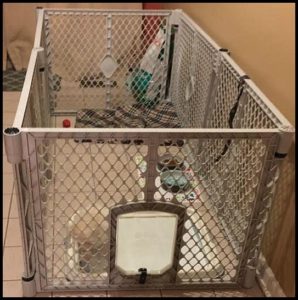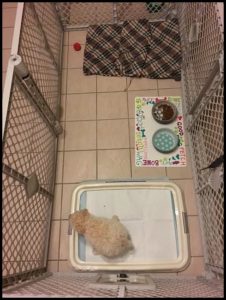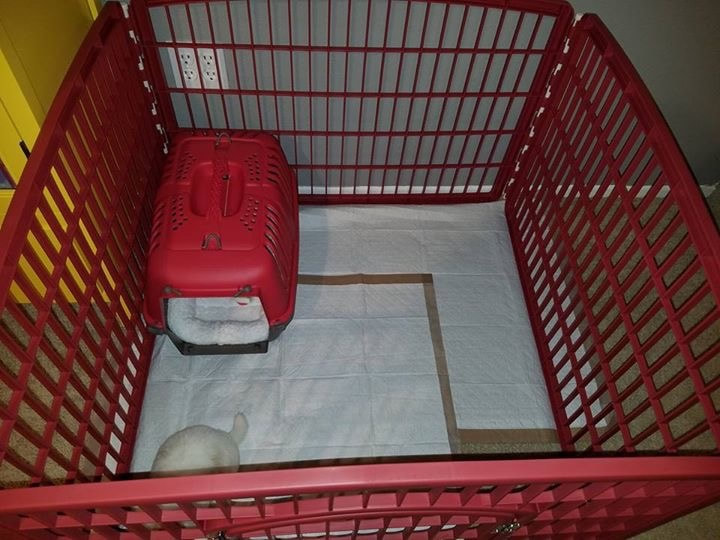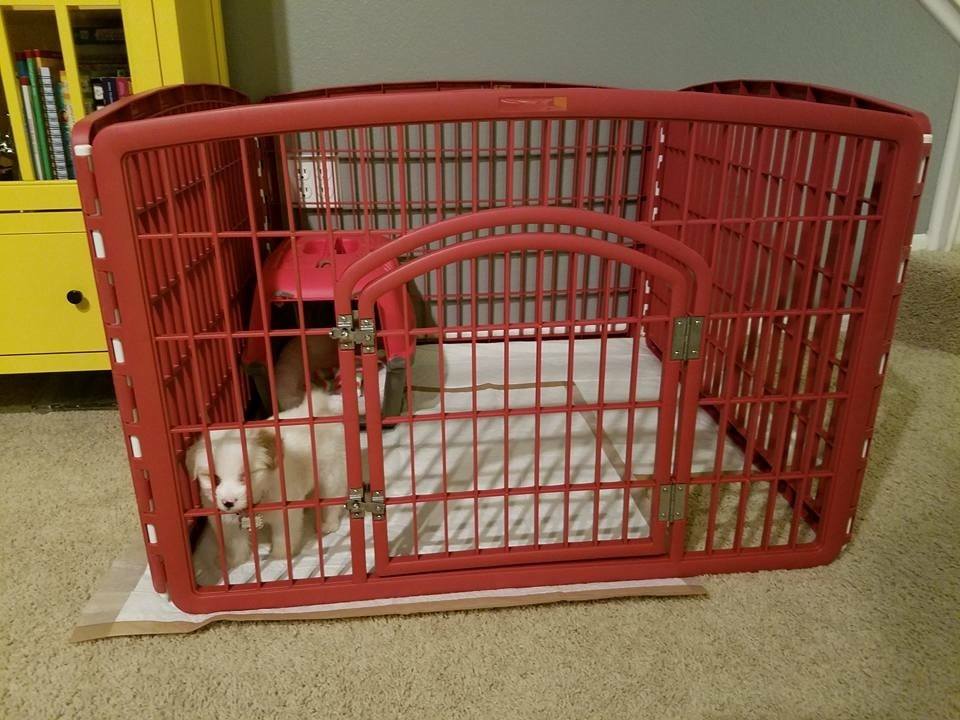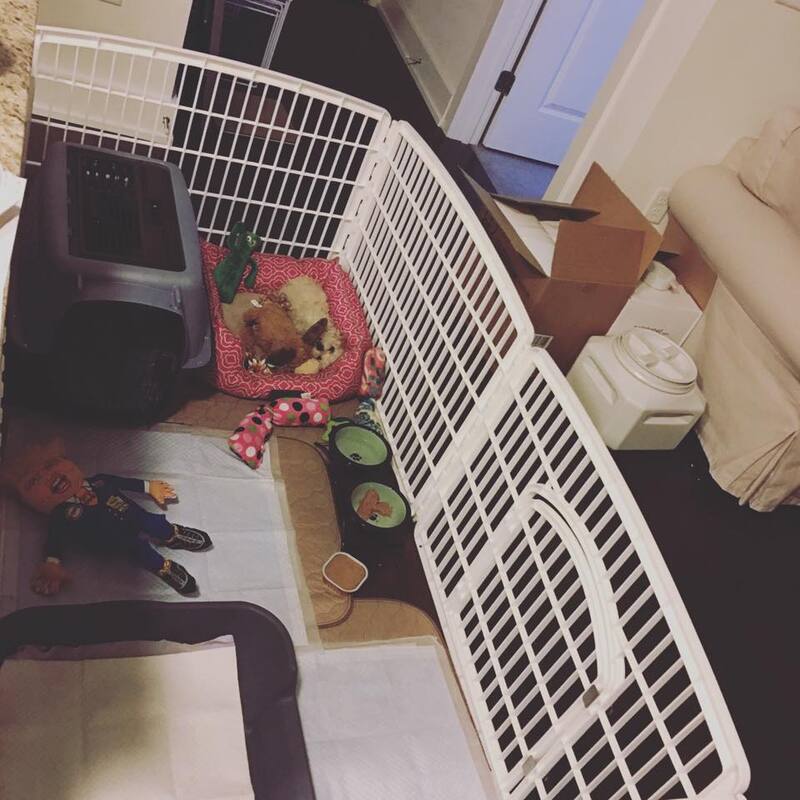|
There are many techniques to use in training your new puppy. However, we have come up with Basic Training Steps that we have tried on our own puppies and have had great results with. One of the most important things to remember is your puppy’s brain is like a little sponge and they learn things so quickly at this young age. Puppies as early as 8+ weeks are at the perfect time to start basic training. With patience, good communications and consistency, your puppy should be on its way to becoming a well behaved pet companion!
TO BEGIN
COMMAND WORDS - before you begin training, come up with a list of basic training command words that everyone agrees upon. We recommend sit, down, stay, off, settle, etc. We do not recommend using the word NO too often. This is an overused word and another more specific word should be used. For example, instead of saying NO for a puppy jumping up, use OFF. Here are some of the basic ones:
PRAISE WORDS - alway use positive words like "GOODBELLA", "YESBELLA" and have a very happy tone to your voice. This will teach your puppy they have done something correctly. PUPPY CLASSES - we highly recommend you enroll your puppy in an age appropriate training class. Remember only after all vaccination records are given (usually after 4 months of age). This is excellent for socializing your puppy with other breeds, people of all ages and ethnicity. SOME PUPPY GAMES Fetch – a classic, of course. To teach your pup to play, get two toys. Throw or roll one, and when Bella grabs it, wave the second toy around so that she’ll come running back. When she gets to you, gently take the first toy, and throw the second one. Toy-on-a-string – great for puppies who need to be encouraged to chase a toy. For some reason, even dogs who don’t like fetch love this game. Chase – Get down on the pup’s level, gently shove her around, then run away. Let her catch you, and praise and offer a toy or treat when she does. This teaches beginner come-when-called skills. (Have the puppy chase YOU, don’t play chase-the-puppy. You don’t want her to learn that running away from her human is a fun game) Puppies love to play, but they have very short attention spans. Hold several 5-15 minute play sessions throughout the day. In the first weeks, some puppies will be too shy or overwhelmed to play. That’s okay. Proceed at her pace, and she’ll come around eventually. It took my shy, very serious puppy Jonas several days before he’d play with me. He eventually became very enthusiastic about fetch and tug-of-war. Always end your puppy command training sessions with play time. Throw a ball, run in the yard, make it fun! Toss a toy…. Do whatever you like to do when playing and relaxing with your puppy. Reward with a treat and say
0 Comments
Thing you need to know:
Few experiences in life match the joy a new puppy brings. The frolicking, affection, and sheer innocence brighten everyone’s day and add a sweet sense of anticipation to returning home. But that joy can fade to frustration for those not prepared to face the challenges a new pup can bring. Happily, neither you nor your new puppy need to suffer through months of frustration. With the right preparation and the proper plan in place, acclimating your new little friend to life with you can be downright fun. As long as you stick to a routine and trust in your puppy’s ability to adapt, time will turn your new recruit into a happy, reliable new addition to the pack.
#1: Housetraining The key to success here is straightforward; your puppy must be put on a rigid schedule and must be either in your presence or else in a crate, yard or dog pen at all times. Yes, this requires ten to sixteen weeks of extreme vigilance but you are setting your pup up for a lifetime of success. It’s all about the groundwork. Obtain a properly sized dog crate, which your puppy will eat and sleep in. The crate mimics the close comfort of a den and uses the canine’s innate dislike for eliminating where he sleeps and eats. This is why crate use is the most successful way to housebreak. Choose a plastic crate, which provides a more secure feeling than a cage-type enclosure. Be sure it is tall enough to let the puppy stand but only long enough to allow her to turn around. It should not be deep enough to let her eliminate in the back and lie down in the front. In most cases, a puppy’s growth rate will require you to move to a larger crate at the four-month stage. Placement of the crate is up to you; some find it convenient to keep it in their bedroom, while others, knowing the puppy will whine, place it outside of the bedroom. Just know that if you respond to the puppy every time she whines you will be training the puppy to whine for attention. Next, set up a schedule. Your puppy needs to eliminate in the early morning, after every meal, after play or walks, whenever she gets excited, and right before bedtime. And, for at least a few weeks, you will probably need to let her out sometime in the very early morning before you would normally awaken. Don’t expect her to last more than four hours during the first month or two. The key is to gradually build up her ability to “hold it,” while teaching her that the home is never a place to eliminate. Feed her in her crate to endear her to it. And commit to her sleeping there; as tempting as it is to respond to whining or crying, if you relent and take her into your bed, you may end up with an accident occurring while you are sleeping. A major benefit of crate training is that your dog will happily settle into a crate should crating be necessary for travel. Never allow your puppy to wander unsupervised in the home until she is thoroughly reliable. Also, be sure to remove all food and water after eight pm. And never leave food down for more than ten minutes. Called free feeding, this makes it difficult to predict when the puppy will need to go. By feeding on a schedule, you “synchronize” your puppy’s system to eliminate predictably. Never hit or rebuke your puppy for accidents. If she has an accident in front of you, interrupt her, calmly saying “no, no no,” then bring to the preferred spot. Avoid cleaning up messes in her presence as it could teach her that playing with waste is okay. If you stick to the routine, your puppy should soon grasp that eliminating outdoors is the ticket. #2 When to Begin Socializing Your Puppy Immediately begin introducing your puppy to family, friends, neighbors, and resident dogs, as well as to dogs you know are safe and properly vaccinated, in a calm, safe, controlled environment. The first few months of your puppy’s life are a key socialization window and you need to acclimate her to as many different people and dogs as possible. You must, however, avoid interaction with unknown dogs until your puppy is fully vaccinated, which occurs around the four-month period. After that, socialize her with safe adult dogs and vaccinated puppies as well. When introducing your puppy to new people, have them take a laid-back approach. Frenetic greetings will only teach her to get overexcited whenever greeting, so be sure to keep it composed and dignified. I tell people to practice “calm indifference” with puppies, much as an adult dog would. Doing so will teach her to be tranquil around guests, instead of jumpy or nervous. Get your puppy out of the home as soon as you can, to greet people and to experience the sights and sounds of the world. Take care not to overwhelm her, though, especially during the eight-to-eleven week period known as the fear imprint stage. During this well-defined period of development, if anything frightening occurs—a loud noise, a backfire, a crack of thunder—it will often stay with the dog for life. It is vital, then that you be cautious during this period, and make sure no sudden sounds or scary events occur. If something does scare your puppy, do not comfort or coddle her, as this will just reinforce and legitimize her frightened reaction. As soon as your puppy passes the four-month immunity stage, take a puppy obedience class with her. You will both learn basic obedience and get lots of socializing time with people and puppies. #3 How Much Exercise is Too Much Exercise? Be sure to walk your puppy, play with her, and teach her to chase and fetch a toy. But go easy on vigorous exercise for at least four to six months, especially with large breeds, whose fast-growing bones can be damaged by over-exercising. Stick to an easy, slow jog, and keep distances down to half a mile until the dog reaches six months. Avoid roughhousing and beware of older dogs playing rough. Going for group walks with family and friends is a great puppy exercise! #4 When and How to Groom Your Puppy Softly brush and comb your puppy every day, and bathe her only when needed. This grooming ritual bonds you to her and also allows you to examine her for lumps, bumps, cuts, or injuries. Handle her legs, ears, tail, and feet, and even look in her mouth. And, with a puppy-sized nail clipper, begin tipping her little nails once per week. Just be sure to only snip off about a sixteenth of an inch, to avoid cutting the “quick” and hurting her. Also gently brush or wipe her teeth, using a soft baby toothbrush or a “finger brush,” available at pet stores. You are laying the groundwork for your dog to welcome handling. #5 What and How Often You Should Feed Your Pup Continue feeding the food the breeder gives you. If you wish to switch foods, do it gradually by mixing a little bit of the new food with old food over a few day period. Feed her three times per day at first, about 1/4 cup per feeding. Give plenty of daily fresh water too. For the first week or so, you can leave their food out so they become familiar where their "food spot" is. #6 How to Raise a Confident, Well Adjusted Dog (It’s all about positive experiences) At three months of age (this is when your puppy is out of the sensitive fear-imprint stage), gradually desensitize her to odd sounds, particularly doorbells, vacuums, lawn mowers, and other potentially distressing noises that can trigger aggression or worry. Take your puppy to the front door and, with a treat in your hand, gently knock on the wood while giving it to her. Praise and repeat. Over a period of days, gradually increase her distance from the door and continue this process of knocking and giving a treat, using a helper to knock. You can do the same with the doorbell. To desensitize her to the vacuum or some other loud appliance, have someone turn on the noisy appliance inside while you and the puppy play outdoors. The sound should be barely discernable to you at this point. Gradually bring her closer while playing and treating her. Eventually, you should be able to run the vacuum with her indoors without problem. Take your puppy into your car right away. At first just sit in it with her, giving her a treat or two. Then, with a friend holding her, drive around the block, praise and go inside. Gradually lengthen the time she can drive until it becomes easy for her. Once she is content in the car, use a crate to transport her in for safety’s sake. By patiently following these six steps, by sticking to routine, you’ll be well on your way to having the perfect puppy that you deserve!
One question I constantly get is “what is the best method for Potty Training my new puppy?” I have tried all sorts of different methods and most were very hard and frustrating. I eventually came across one method that is so simple and easy and I tried it on my own puppies and dogs, and sure enough, this method really works!
To begin, it is strongly recommended that you be home with your puppy during the first two weeks following arrival. When you can spend the majority of the daylight hours with your new puppy, you will begin to see positive results twice as fast as someone who isn’t available as much and therefore, cannot give as much supervision. Please remember, puppies do have accidents and that each puppy learns on an individual basis. Just be patient. Toy breeds have smaller stomach, and after the first few days, they seem to eat in a browsing fashion due to the many distractions and smells of their new environment. At first (until they can control their bladders better), your puppy should be ready to go potty around 30-40 minutes after eating or drinking. For the first few weeks, leave out food and water, in the same location, so they can become familiar with where their food is. After a few weeks, start them on a feeding schedule, generally feeding them three times a day, until about 1 year of age. Remove the meal after 30 minutes; this will help your puppy develop a regular eating pattern and elimination schedule. 1st STEP: The easiest way to set up a puppy area for potty training is to confine the puppy in their “own” space. It can be a small hallway, laundry room, utility room, part of the kitchen, as long as the area can be closed off with some type of gate or closure. We suggest a “Puppy Apartment” if you don’t have a small room. You can also purchase gates, or several gates to make your enclosure. 2nd STEP: place puppy bed, food & water, newspaper (potty pad) as illustrated above. Leave enough room in the middle for a small area. Puppies do not like to potty where they sleep, eat or play. So guess where they will go? That’s right: on the newspaper or pee pad. Remember if you see them going, praise them and give an appropriate treat. 3rd STEP: put your puppy in their new “room” with a few toys. Rotate the toys often as they love to receive new toys. Try to keep your puppy in their new rooms at least 20 – 30 minutes each day, or whenever you are around to supervise them. You want their new room to be a safe haven, non-threatening place for them to go, and have their own time and space, away from all distractions of your household. Remember, when you see them going potty, praise him and give an appropriate treat. Make their room, a special place. Each time you put your puppy in their “space” use the command word “BELLA ROOM”. Eventually, they will go in their room on their own. After your puppy gets the routine of going on the potty pad (or newspaper) down pat, you are ready for next step. This could take just a few days or a few weeks. Every puppy catches on at a different pace. 4th STEP: Place the newspaper near the door where you want the puppy to go out for a few days. Then move the paper outside (weather permitted). They will want to go to the paper and will let you know at the door. You can always hang a bell and use their nose or paw to ring the bell each time before they go out. Use a command word like “BELLA POTTY” or “BELLA OUTSIDE”. Praise them when they go outside. Some apartment dwellers put the newspaper shredded up in a kitty litter box or kitty litter in place of newspaper or pee pads. One of the best things about this potty training method is the puppy can have their own space and have everything they need. They are not out running around tearing or chewing things up. You will know your puppy is safe and happy, and most importantly they will feel secure in their new environment even when left alone. |
CATEGORIES
TRAINING - Basic Training - Crate Training - Potty Training - 6 Steps to Perfect Pup - Tips GENERAL INFO - Our Breeds - Male vs. Female - Colors of mixed Breed HEALTH -Pumpkin Benefits -No eating foods - Giardia - Coccidia -Tear Stains - Health Insurance |
